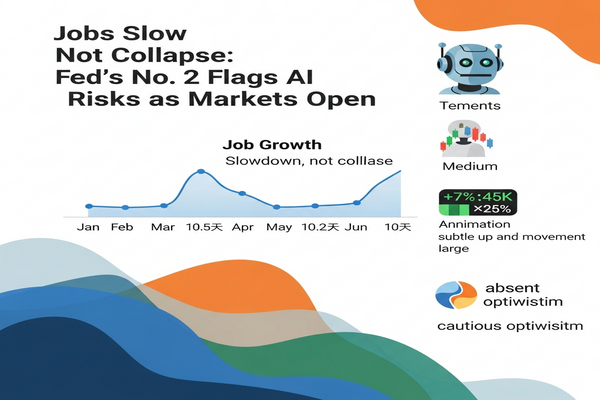
U.S. job market shows slowing, not collapsing. October data from private and regional sources point to steady but weaker hiring, with ADP (NASDAQ:ADP) showing a modest 42,000 private payroll gain and the Chicago Fed estimating unemployment at 4.36 percent versus the last official 4.32 percent in August. That matters now because softening jobs could alter the Federal Reserve’s path and react to Fed vice chair Philip Jefferson’s public comments about AI’s mixed inflation effects. Short term, markets will watch payroll proxies and claims. Longer term, AI and structural hiring changes could change productivity and sector risk across the US, Europe and Asia.
October snapshot: slowing, not collapsing
Private and state-level releases compiled during the government shutdown paint a consistent picture. Payroll processor ADP (NASDAQ:ADP) reported a rebound of 42,000 private sector jobs in October after two months of declines. The Chicago Fed’s estimate of the unemployment rate rose to 4.36 percent for October. That is a small move from August’s 4.32 percent government reading and not the kind of surge seen before past recessions.
Weekly initial claims remain low by historical standards. JPMorgan economists (NYSE:JPM) estimate last week’s initial claims at about 229,000, up from 220,000 the week before. State-released claims data across the country also show only a gradual increase rather than a spike. Meanwhile, job postings on Indeed hit their lowest level in four years through October 31, and posted wage growth year over year has slowed to roughly 2.5 percent, below recent inflation readings.
One distortion matters for headline payrolls. The federal government likely ran a one-time drop in October employment after paying federal workers through September 30 under the deferred resignation program. That mechanical adjustment could produce an apparent payroll contraction even as private hiring remains positive. Traders should treat headline nonfarm payrolls with caution until the government data resume normal operations.
Fed thinking: AI can push inflation down or up
Federal Reserve vice chair Philip Jefferson used a rare AI-focused speech to signal that the technology is already influencing hiring, productivity and prices, but that the net effect remains uncertain. Jefferson said AI may raise productivity and lower costs, which could ease inflationary pressures. He also warned that data center buildouts can raise utility and land costs for some communities, creating upward pressure on prices.
Those comments arrive as the Fed debates whether to move again on policy this year. Jefferson described policy as somewhat restrictive but closer to neutral. He advocated caution as officials approach the neutral rate, suggesting a slower pace for future moves while official data remain thin due to the shutdown. Markets will parse his remarks for whether they tilt the balance toward another cut or toward patience.
Globally, the AI debate has similar implications. In Europe and Asia, firms that adopt AI may find margins and productivity improve, but local infrastructure and energy constraints could create localized price pressure. Emerging markets that supply data center components, power inputs, or skilled labor could see demand shifts that matter for trade flows and capital spending patterns.
Market implications for equities, bonds and currencies
Equity markets may trade cautiously on the mix of softening labor indicators and Fed caution. Sectors tied to consumer spending could feel pressure if sentiment and posted wages stall further. Technology and AI-exposed firms will face two-way forces, with potential margin gains offset by higher infrastructure costs in regions with strained power grids.
Fixed income traders will focus on incoming labor signals and the tone from Fed speakers. If labor data appear only modestly weaker and the Fed sounds patient, yields could drift. If evidence mounts that hiring is materially weakening, the debate over additional easing later this cycle could intensify, which tends to compress term premiums and lower yields. Currency markets react to both the interest rate path and growth differentials. A softer US labor backdrop with Fed caution could weigh on the dollar relative to major peers, while pockets of strength in other economies would lift their currencies.
Commodities and energy may see divergent moves. If tech-driven demand for data center power rises, natural gas and electricity prices in affected regions could move higher. That dynamic could support energy names in certain markets while pressuring industrial margins in others.
Trading session preview: what to watch today
Today’s session opens with traders parsing payroll proxies and regional claims. Look for volatility around any fresh state-level claims releases and commentary from other Fed officials. Market participants will treat the Chicago Fed’s unemployment estimate and the ADP private payrolls as key inputs into how the November nonfarm payrolls might look once regular government releases resume.
Sentiment measures also matter. Preliminary University of Michigan consumer sentiment slid roughly three percentage points to the lowest since 2022 in November, with the drop broad based except for those holding large stock positions. That decline could mute consumer-facing equities if it persists through retail and services data later in the month.
Keep an eye on corporate headlines. Announced layoff counts have risen, but actual unemployment filings remain contained for now. If layoff announcements continue, markets will reassess the gap between future risk and current outcomes. Watch technology capital spending plans and data center announcements for clues on AI-related infrastructure demand and regional energy implications.
Risk management and scenario planning will guide desk behavior. In the near term, traders are likely to favor liquidity and clarity over large directional bets, given thin official data and a Fed asking for patience. Over the medium term, AI’s impact on productivity and costs will be a structural factor that alters sector weights and cross border capital flows, with different implications for the US, Europe, Asia and emerging markets.
This preview uses available private and regional measures to provide a market frame for the coming session. It is informational and not a recommendation. Assess asset moves against your own time horizon and risk parameters, and monitor Fed commentary and state claims updates for fresh guidance as the day unfolds.












